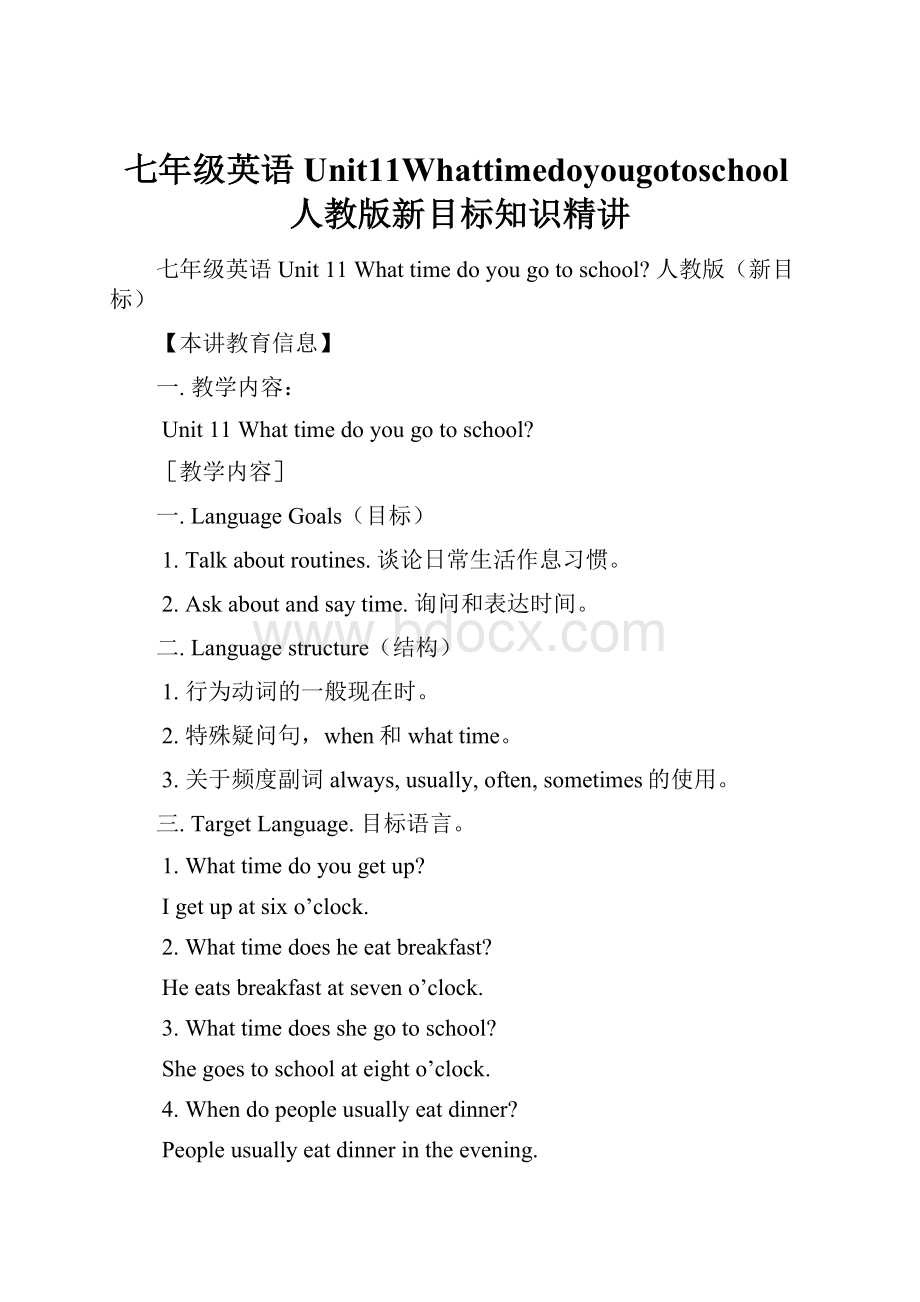七年级英语Unit11Whattimedoyougotoschool人教版新目标知识精讲.docx
《七年级英语Unit11Whattimedoyougotoschool人教版新目标知识精讲.docx》由会员分享,可在线阅读,更多相关《七年级英语Unit11Whattimedoyougotoschool人教版新目标知识精讲.docx(22页珍藏版)》请在冰豆网上搜索。

七年级英语Unit11Whattimedoyougotoschool人教版新目标知识精讲
七年级英语Unit11Whattimedoyougotoschool?
人教版(新目标)
【本讲教育信息】
一.教学内容:
Unit11Whattimedoyougotoschool?
[教学内容]
一.LanguageGoals(目标)
1.Talkaboutroutines.谈论日常生活作息习惯。
2.Askaboutandsaytime.询问和表达时间。
二.Languagestructure(结构)
1.行为动词的一般现在时。
2.特殊疑问句,when和whattime。
3.关于频度副词always,usually,often,sometimes的使用。
三.TargetLanguage.目标语言。
1.Whattimedoyougetup?
Igetupatsixo’clock.
2.Whattimedoesheeatbreakfast?
Heeatsbreakfastatseveno’clock.
3.Whattimedoesshegotoschool?
Shegoestoschoolateighto’clock.
4.Whendopeopleusuallyeatdinner?
Peopleusuallyeatdinnerintheevening.
5.Whattimeisit?
It’seight-thirty.
四.KeyPhrases(重点词组)
△动词短语
getup起床
gethome到达家中
gettowork到达工作岗位
makebreakfast做早饭
makeashowerschedule做一个洗澡的安排
practiceguitar练吉它
leavehome离家
takeashower=haveashower洗淋浴澡
taketheNumber17bustotheSantonHotel
乘17路公共汽车去Santon旅馆
gotoclass上课
gotoschool上学
gotowork上班(反义词gohome)
havebreakfast/dinner/lunch吃早、晚、午饭
gotobed睡觉(反义词getup)
puton穿衣服(反义词takeoff)
doone’shomework做家庭作业
tellsb.aboutsth.告诉某人某事
knowaboutsth.知道某方面的情况
lovetodo=liketodo喜欢干某事
listentotheearlymorningnewsonradio
听电台早间新闻
watchtheearlymorningnewsonTV
看电视早间新闻
△其他短语
aroundsixo’clock六点左右
inthemorning在早上
intheafternoon在下午
intheevening在晚上
listento听…
五.KeyPoints(疑难解析)
1.Whattimeisit?
It’s…
这是询问时间的惯用法,如:
A:
Excuseme.Whattimeisit,please?
请问几点了?
B:
It’snineo’clock.九点了。
英语时间的表达
(1)整点时间可表示为“钟点数+o’clock”或直接读钟点数,省去o’clock。
如:
It’steno’clocka.m.现在是上午十点整。
(2)非整点时间可直接采取读数法。
如:
It’seight-thirty.是八点三十分。
注意时间的表达方式:
用数词。
点与分钟之间用连字如:
eleven-thirty十一点三十分
nine-twenty-five九点二十五分
6:
10→six-ten8:
50→eight-fifty
9:
30→nine-thirty10:
15→ten-fifteen
7:
45→sevenforty-five11:
05→eleven-five
(3)非整点时间的分钟数不超过30分钟,也可用介词“past”。
如:
6:
10→tenpastsix
11:
05→fivepasteleven
10:
15→aquarterpastten或fifteenpastten
8:
15→aquarterpasteight或fifteenpasteight
9:
30→halfpastnine或thirtypastnine
(4)非整点时间的分钟数超过30分钟,用介词to。
如:
11:
50→tentotwelve
7:
31→twenty-ninetoeight
9:
45→aquartertoten或fifteentoten
12:
59→onetothirteen
此句话还有几种表达方式。
如:
Whatisthetime?
几点了?
Whattimeisitbyyourwatch?
你的手表几点了?
用英语大声说出下列表格中的时间
A:
What’sthetime,please?
B:
It’stwelveo’clock.
8:
05ofive.
8:
10ten.
8:
15It’seightfifteen.
8:
25twenty-five.
8:
30thirty.
OR
five
ten
It’saquarterpasteight.
twenty-five
half
8:
35thirth-five.
8:
40forty.
8:
45It’seightforty-five.
8:
50fifty.
8:
55fifty-five.
OR
twenty-five
twenty
It’saquartertonine
ten
five
2.whattime与when
whattime翻译为“几点”问的是具体的时间,一般回答要具体到小时。
Whattimedoyougotoschool?
你什么时候/几点上学?
Igotoschoolathalfpastseveno’clock.
我七点半去上学。
回答具体到点钟,且注意在几点前边的介词用at。
when也是对时间的提问,但与whattime的区别是:
用when提问,回答既可以是具体的时间,也可以是不具体的时间,如:
inthemorning,lastyear,in1998等范围大的时间,例如:
Whendoeshetakeashower?
他什么时候洗澡?
Hetakesashowerinthemorning.
他在早上洗澡。
也可用具体时间:
Itakeashowerat6o’clockinthemorning.
我早上六点洗澡。
例.对下列划线部分提问,将句子变为特殊疑问句。
(1)It’sseveno’clock.
____________________isit?
(2)Hewasbornin1992.
__________was__________born?
解析:
本题主要考查when与whattime如何询问时间。
答案:
(1)Whattime
(2)When,he
3.关于一般现在时。
(语法重点)
(1)一般现在时态的意义是:
①表示现在的特征或状态。
如:
Heisathometoday.他今天在家。
②表示经常性、习惯性的动作。
常和频率副词always,often,usually及everyday等表示时间的短语连用。
如:
Igotoschoolat7:
00everyday.我每天7点钟去上学。
③表示主语具备的性格或能力。
如:
Shelikespearsverymuch.她非常喜欢梨子。
TheyspeakEnglish.他们讲英语。
(2)肯定陈述句:
当主语是第一、二和第三人称复数时,谓语动词用原形。
当主语是第三人称单数时,谓语动词用第三人称单数形式。
例如:
①TheystayathomeonSundays.
他们星期天呆在家。
②Hedoeshishomeworkintheevening.
他在晚上做作业。
(3)否定句:
当主语是第一、二及第三人称复数时,否定句借助助动词do+not,当主语是第三人称单数时,否定句借用does+not,并将动词第三人称单数还原。
例如:
①Theydon’tstayathomeonSundays.
他们星期天不呆在家里。
②Hedoesn’tdohishomeworkintheevening.
他晚上不做作业。
(4)疑问句:
当主语是第一、第二及第三人称复数时,疑问句在句首加Do。
当主语是第三人称单数时,疑问句在句首加Does,并把谓语第三人称单数还原。
例如:
①DotheystayathomeonSundays?
他们星期天呆在家吗?
②Doeshedohishomeworkintheevening?
他晚上做作业吗?
△以speak为例归纳动词do的各种句式:
肯定式
否定式
IspeakEnglish.
YouspeakEnglish.
He/She/ItspeaksEnglish.
We/You/TheyspeakEnglish.
Idonot(don’t)speakEnglish.
Youdonot(don’t)speakEnglish.
He/She/Itdoesnot(doesn’t)speakEnglish.
We/You/Theydonot(don’t)speakEnglish.
疑问式和简略答语
DoIspeakEnglish?
Yes,youdo.
No,youdonot(don’t).
DowespeakEnglish?
Yes,we/youdo.
No,we/youdonot(don’t).
DoyouspeakEnglish?
Yes,Ido.
No,Idonot(don’t).
DoyouspeakEnglish?
Yes,wedo.
No,wedonot(don’t).
Doeshe/she/itspeakEnglish.
Yes,he/she/itdoes.
No,he/she/itdoesnot(doesn’t).
DotheyspeakEnglish?
Yes,theydo.
No,theydonot(don’t).
(1)We__________(getup/getsup)atseveneverymorning.
(2)Jane__________(don’twakeup/doesn’twakeup)atsixeverymorning.
(3)Myfatheroften__________(drink/drinks)lemonadeforbreakfast.
(4)____________(Does,Do)thegirloften__________(draw/draws)picturesinthepark?
(5)Myfriendoften__________(come/comes)toschoolbybus.
(6)____________(Does,Do)SallyandAnnoften__________(read/reads)Englishinclass?
(7)Jim__________(doesn’tdo/doesn’t)hishomeworkaftersuppereveryday.
(8)Jone__________(go/goes)homeat4:
00intheafternoon.
答案:
(1)getup
(2)doesn’twakeup(3)drinks
(4)Does,draw(5)comes(6)Do,read
(7)doesn’tdo(8)goes
解析:
本题考查一般现在时的各种句型。
(1)主语是we,与谓语动词原形搭配。
(2)考查否定句,由于主语是第三人称单数,助动词应相应变化。
(3)主语是第三人称单数。
(4)行为动词是一般现在时的疑问句,主语thegirl是第三人称单数,助动词应选相应的Does,后面的动词则用原形,选draw。
(5)此题与(3)题考点相同,选comes。
(6)此题与(4)小题考点一样,但主语SallyandAnn相当于they,不是单数,答案为Do,read。
(7)此题较难,不能丢了第二个do,它是主语的动词译为“做”,答案为doesn’tdo。
(8)考点与(3)、(5)相同。
4.always,usually,often和sometimes
这四个副词表示行动或动作的频率。
频率最高的是always(总是),其次是usually(通常,总是),often(经常,时常),sometimes(有时),使用时要注意它们在句中的位置。
由于频率副词表示的是经常性的、一般性的动作或情况,不是具体指某一次,因此常常和一般现在时连用,常位于行为动词前面,其他动词(指be动词、情态动词和助动词)的后面。
本单元重点学习usually“通常”。
如:
Whendoyouusuallygetup?
你通常什么时候起床?
Iusuallygetupatsixo’clock.
我通常六点起床。
Whattimedoesyoursisterusuallygetup?
你妹妹通常什么时候起床?
Sheusuallygetsupat6:
30.
她通常6:
30起床。
5.在本单元中,出现了大量的动词短语,我们通过下面的题目来巩固一下。
填空完成短文,注意词形变化。
Scottworksvery___1___(长时间地).Heusually___2___(起床)at17:
00.He___3___(洗澡)and___4___(做早饭).Whatafunnytimetomakebreakfast!
___5___(早饭后),hepracticeshisguitar,thenhe___6___(穿上)hisjacketand___7___(上班).___8___(为了到达工作岗位).He___9___(乘17路公汽)totheSantonHotel.Thebususuallyleavesat9:
15.Heworks___10___(通宵).Peoplelove___11___(听他说话)!
He___12___(到家)at7:
00andwatchestheearlymorningnewsonTV.He___13___(睡觉)at8:
30,atiredbuthappyman.Canyouthinkwhathisjobis?
解析:
这篇短文是本单元67页上的阅读文章,出现了不少习惯用语,同学们一定要大声反复诵读直到脱口而出,增加语感,品味出词语在具体语境中的用法,从而将知识和能力融合为一体,举一反三,灵活运用。
另外,一般现在时第三人称单数形式仍然是难点,不少同学,一看就会,一听就懂。
可是一开口、一动手就错,什么原因呢?
就是练习少了,用中国的思维方式学英语,解决这个问题的惟一办法就是行动起来,参与交际活动,反复应用,脱口而出。
学地道的英语,不是一味地背语法条款。
答案:
(1)longhours(复数)
(2)getsup(第三人称单数)
(3)takes/hasashower(第三人称单数)
(4)makes(his)breakfast
(5)Afterbreakfast(表示时间的介词短语)
(6)putson
(7)goestowork
(8)Togettowork(动词不定式)
(9)takestheNumber17bus
(10)allnight
(11)tolistentohim(动词不定式)
(12)getshome
(13)goestobed
6.Whatafunnytimetomakebreakfast!
多么可笑的做早饭的时间啊!
这是一个以what开头的感叹句,不是特殊疑问句。
△感叹句用来表示感情的喜、怒、哀、乐等,其结构为感叹词(what,how)+强调成分+主语+动词等。
what用来强调句中的名词,how用来强调句中的形容词、副词或动词。
例如:
Whatafinedayitistoday!
今天天气多好啊!
Whatinterestingbookstheyare!
多有趣的书啊!
Howbeautifulthegardenis!
这个花园多美呀!
例.Itisaninterestingmovie.(将句子变为以what和how开头的感叹句,句意相近)
(1)___________________________movieitis!
(2)_________interestingthemovieis!
解析:
本题考查感叹句的结构。
答案:
(1)Whataninteresting
(2)How
7.listento,hear和sound
△listento意为“注意听”,表示有意识地去听,但不一定听得见什么,强调听的动作。
(listen不及物,listento及物)如:
Theyarelisteningtotheteacher.他们在听老师说。
△hear意为“听见”,表示耳朵里听到了,但不一定有意识地听,强调听的结果。
如:
I’msorrytohearthat.
听到那个消息我很难过。
△sound意为“听起来,听上去”,可作连系动词,后接形容词作表语,还可以和like连用。
例如:
Themusicsoundssweet.这音乐听起来悦耳。
例.用hear,listento,sound填空。
(1)Bequiet!
(安静)__________________theactor.Ican’t_________him.
(2)Let’splaybasketball.
That_________good.
解析:
(1)句意:
安静!
听演员说。
我听不见他的话。
第一个“听”强调听的过程。
第二个听强调听的结果(听不见)。
(2)句意:
我们打篮球吧!
听上去不错。
答案:
(1)Listen,to,hear
(2)sounds
8.Togettowork,hetakesthenumber17bustotheSaiteHotel.
为了赶去上班,他要乘坐去赛特宾馆的17路公共汽车。
(1)togettowork是动词不定式作目的状语。
(2)takeabus表示“乘坐公共汽车”。
如:
Igettoschoolat8:
15.我八点一刻到达学校。
9.Thanksforyourletter.谢谢你的来信。
Thanksfor…谢谢……,其后接名词,或相当于名词的词。
如:
Thanksforyourhelp.多谢你的帮忙。
Thanksforcomingtoseeme.谢谢来看我。
10.Iusuallygetupataroundsixfifteen.
我通常在大约六点一刻时起床。
around表示“大约”的意思。
around还可表示“在周围,在附近”,“朝……四处”。
如:
Therearearound100peopleinthehall.
大厅里大约有一百人。
Shelooksaroundtheroom.她环顾一下室内。
11.Schoolstartsatnineo’clock.
九点钟学校开始上课。
start动词,表示“开始”的意思,相当于begin。
开始做某事
如:
Whattimedoesthepartystart?
聚会几点开始?
Itstartstorain(raining).开始下雨了。
Heusuallystartsstudyingateightathome.
他在家通常8点开始学习。
六.知识点巩固
1.Heisalwaysthelastone_________toschool.
A.goesB.togoC.goD.togoes
2.He_________upat7:
00and_________theearlymorningnewsonTV.
A.gets,seesB.gets,watchs
C.gets,watchesD.gets,towatches
3.Hereareyourpants._________!
A.PutthemonB.Putonthem
C.PutitonD.Putonit
4.Tonyusuallygetsup_________5o’clock.
A.inB.atC.onD.about
5.Lucy,canyou_________meaboutyourschool?
A.talkB.tellC.speakD.know
6.Doyouwanttoknow_________mymorning?
A.aboutB